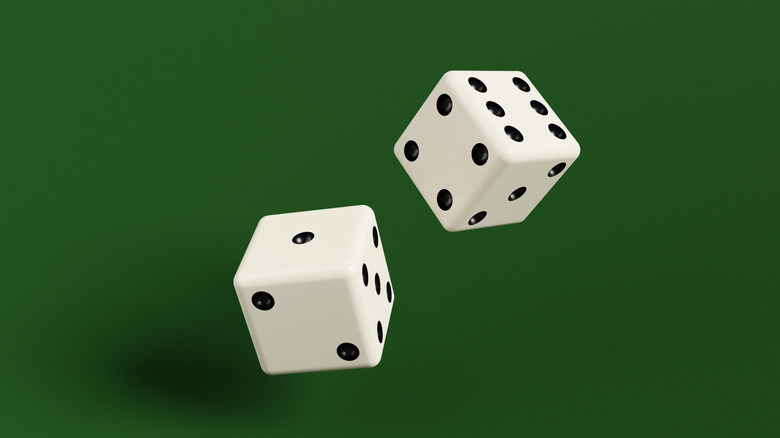How To Calculate Dice Probabilities
Whether you're wondering what your chances of success are in a game or are just preparing for an assignment or exam on probabilities, understanding dice probabilities is a good starting point. Not only does it introduce you to the basics of calculating probabilities, it's also directly relevant to craps and board games. It's easy to figure out the probabilities for dice, and you can build your knowledge from the basics to complex calculations in just a few steps.
One Die Rolls: The Basics of Probabilities
The simplest case when you're learning to calculate dice probability is the chance of getting a specific number with one die. The basic rule for probability is that you calculate it by looking at the number of possible outcomes in comparison to the outcome you're interested in. So for a die, there are six faces, and for any roll, there are six possible outcomes. There is only one outcome you're interested in, no matter which number you choose.
The formula you use is:
(text{Probability} = frac{text{Number of desired outcomes}}{text{Number of possible outcomes}})
For the odds of rolling a specific number (6, for example) on a die, this gives:
(text{Probability} = 1 ÷ 6 = 0.167)
Probabilities are given as numbers between 0 (no chance) and 1 (certainty), but you can multiply this by 100 to get a percentage. So the chance of rolling a 6 on a single die is 16.7%.
Two or More Dice: Independent Probabilities
If you're interested in rolls of two dice, the probabilities are still simple to work out. If you want to know the likelihood of getting two 6s when you roll two dice, you are calculating "independent probabilities." This is because the result of one die doesn't depend on the result of the other die at all. This essentially leaves you with two separate one-in-six chances.
The rule for independent probabilities is that you multiply the individual probabilities together to get your result. As a formula, this is:
(text{Probability of both} = text{Probability of outcome one} × text{Probability of outcome two})
This is easiest if you work in fractions. For rolling matching numbers (two 6s, for example) from two dice, you have two 1/6 chances. So the result is:
(text{Probability} = frac{1}{6} × frac{1}{6} = frac{1}{36})
To get a numerical result, you complete the final division:
(frac{1}{36}=1 ÷ 36 = 0.0278)
As a percentage, this is 2.78%.
This gets a bit more complicated if you're looking for the probability of getting two specific different numbers on two dice. For example, if you're looking for a 4 and a 5, it doesn't matter which die you roll the 4 with or which you roll the 5 with. In this case, it's best to just think about it as in the previous section. Out of the 36 possible results, you're interested in two outcomes, so:
(text{Probability} = frac{text{Number of desired outcomes}}{text{Number of possible outcomes}} = frac{2}{36} = 0.0556)
As a percentage, this is 5.56%. Note that this is twice as likely as rolling two 6s.
Total Score From Two or More Dice
If you want to know how likely it is to get a certain total score from rolling two or more dice, it's best to fall back on the simple rule: Probability = Number of desired outcomes ÷ Number of possible outcomes. As before, you determine the total outcome possibilities by multiplying the number of sides on one die by the number of sides on the other. Unfortunately, counting the number of outcomes you're interested in means a little bit more work.
For getting a total score of 4 on two dice, this can be achieved by rolling a 1 and 3, 2 and 2, or a 3 and 1. You have to consider the dice separately, so even though the result is the same, a 1 on the first die and a 3 on the second die is a different outcome from a 3 on the first die and a 1 on the second die.
For rolling a 4, we know there are three ways to get the outcome desired. As before, there are 36 possible outcomes. So we can work this out as follows:
(text{Probability} = frac{text{Number of desired outcomes}}{text{Number of possible outcomes}} = frac{3}{36}=0.0833)
As a percentage, this is 8.33%. For two dice, 7 is the most likely result, with six ways to achieve it. In this case, probability = 6 ÷ 36 = 0.167 = 16.7%.
